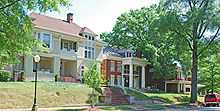Fort Wood Historic District
|
Fort Wood Historic District | |
 | |
|
Fort Wood District looking down Oak Street | |
 | |
| Location |
Roughly bounded by Palmetto, McCallie, E. 4th St and O'Neal St Chattanooga, Tennessee |
|---|---|
| Coordinates | 35°02′41″N 85°17′31″W / 35.0448°N 85.2920°WCoordinates: 35°02′41″N 85°17′31″W / 35.0448°N 85.2920°W |
| NRHP Reference # | 79002437 |
| Added to NRHP | April 18, 1979 |
The Fort Wood National Historic District is a historic neighborhood in Chattanooga, Tennessee. On April 17, 1979, Fort Wood Historic District became certified by the National Park Service as a national historic site. It is bounded roughly by Palmetto Street, McCallie Avenue, East 4th Street, and O'Neal Street, and located just east of the University of Tennessee at Chattanooga campus.
History


A fortification during the Civil War, the land making up the neighborhood was sold to developers in the 1880s. The original "fort" was a stronghold constructed by Union forces in 1863 during their occupation of Chattanooga. The fort was originally named after Colonel William R. Creighton, and was later renamed in 1864 in honor of General Thomas Wood. The National Park Service has placed several war-era cannons in the neighborhood to commemorate its historical interpretation of the fort.[1] Before long, Fort Wood became one of Chattanooga's finest residential neighborhoods, and it retains an excellent representation of Chattanooga architecture from the 1880s to the 1920s. There are approximately 106 buildings, many of which are excellent examples of Queen Anne, Tudor Revival, and Romanesque Revival styles, as well as many others. Architectural styles used in the homes of important Fort Wood residents reflected their wealth and interest in the fashions of the day.
Decline
By the mid 1950s, the Fort Wood neighborhood was in a steady decline. Like many neighborhoods in the surrounding decades, a degree of "white flight" had many residents leaving for more affluent suburbs such as Signal Mountain, Hixson, and East Brainerd.
By the 1970s, the neighborhood's situation had become critical. Many of the buildings in and around Fort Wood had fallen into disrepair or had become victims of vandalism or arson. The neighborhood's bad reputation began to affect the students of nearby UT Chattanooga, many of whom moved off campus and stopped enrolling in evening classes.
Rebirth
Between 1900 and 1910, Fort Wood became one of the most exclusive residential sections in Chattanooga. Many of Chattanooga's leading citizens built their homes in Fort Wood, including T.C. Thompson, the mayor of Chattanooga from 1909-1915; George Fort Milton, publisher and part owner of the Chattanooga News, and Samuel Reed, owner of the Reed House, an important hotel in downtown Chattanooga.[2] By the early 1980s, revitalization efforts were underway, exemplified by the restoration of the Warner House at the corner of Vine and Palmetto Streets. Within the next couple of decades, the home of Edmond G. Watkins, later the mayor of Chattanooga, was finished being constructed. The structure was more than just a home for his family and himself. It was a monument to the rebirth of the south after surviving the Civil war. Today, the mayor's home has been restored and turned into an inn, cleverly named Mayor's Mansion Inn. The inn contains over 13,000 square feet and boasts 5 beautifully appointed rooms and 6 lavish suites, each which their own private baths. Also, the city council had given the Fort Wood area statutory zoning protection and many more houses were under renovation. Today, many of the homes in Fort Wood have been converted into apartments. Indeed, student apartments in this area are highly sought after by UTC students who wish to live off, but close to, the campus. One reason for this demand may be attributed to UTC's strict alcohol free policy. Fort Wood's historic preservation is ongoing and land values are rising. Several fraternity and sorority houses, including Chi Omega, Lambda Chi Alpha, Kappa Sigma, and Gamma Phi Beta are located in Fort Wood. The houses are an obvious choice due to Fort Wood's close to proximity to the University of UTC, as well as the number of rooms and large size of the houses.
Today (2014), very few of the homes in Fort Wood are student housing. The majority of the homes are private residences which have been renovated to their original purpose and grandeur.
Notable structures
- Warner House (1891)
- William Gibbs McAdoo house (1888)
- Fort Wood Apartments (1904)
- Kappa Sigma Fraternity House (1903)
- Mizpah Congregation synagogue (c. 1928)
- 926 Oak Street Lambda Chi Alpha Fraternity House (1909)
- Z.C. Patten House (1892) – Known to most UTC students as "Patten House," home of the Alumni Affairs Department. Also notable are the two Civil War-era cannon on the front lawn.
- 900 Oak St, Former Pi Kappa Alpha and Phi Delta Theta Fraternity House[3] now home to a Twelve Tribes Community[4]
Mayor Edmund Watkins House, 801 Vine Street. Built in 1889, now operated as the Mayor's Mansion Inn Bed and Breakfast.
References
- ↑ http://www.historicfortwood.org/index.php?/custom/article/about/
- ↑ http://www.historicfortwood.org/index.php?/custom/article/about/
- ↑ UT Chattanooga. "UTC Student Handbook Online" (PDF). UT Chattanooga. Retrieved 2009-12-12.
- ↑ Twelve Tribes. "Twelve Tribes Community in Chattanooga". Intentional Communities. Intentional Communities. Retrieved 2009-12-12.
External links
- Cornerstones, Inc., page about Fort Wood area
- Article regarding the clash between college students and older residents
- Chattanooga Department of Neighborhood Services
Site giving information from the National Register of Historic Places